This page will show you the steps you can take to try and uncover a soldier’s army number. I have a separate page explaining what an army number was and how to find a personal number, the officers’ equivalent. This is just one of a series of guides I’ve created to help you research those who served in the British Army during the Second World War:
I offer a Second World War Soldier Research and Document Copying Service.
Why is Finding a Soldier’s Army Number so Important?
During the Second World War, each soldier who served in the British Army was allotted a unique army number, usually on the day they joined or shortly after. Finding a soldier’s army number is very important if you want to order their service record from the Ministry of Defence or the National Archives. While a search can be carried out using a soldier’s date of birth, many recruits gave a false one. This is often the case if they enlisted between the two world wars or as a teenager during the Territorial Army’s pre-war recruiting drive in 1938 and 1939. In addition, if a soldier had a common name, e.g. John Smith or James Taylor, there may be multiple men with the same name and date of birth. However, if you know a soldier’s army number, then you won’t have to worry about being sent the wrong service record, or having to provide additional information. An army number is also important if you don’t want to order a soldier’s service record, or while you wait for it to arrive as you can:
- Check to see if the soldier died during or shortly after the war by searching the number on the Commonwealth War Graves Commission’s website
- Search the army number in the National Archives’ catalogue to see if you get a hit. If the soldier became a prisoner of war or was awarded a gallantry medal, then you have a good chance of a record appearing. If their service record has been added to the catalogue, then their date of birth should appear which may enable you to research their background through census records, the National Register, etc.
- Search the army number in the military section of Findmypast. There aren’t that many resources online for Second World War soldiers but Findmypast has a lot of important ones. These include the British Army’s Casualty Lists, Royal Artillery Attestations 1883-1942, and Royal Engineers Index Cards
- If you’re researching a soldier who served in the Royal Artillery, check the Royal Artillery Tracer Cards, 1939-1948 on Ancestry. I have found this collection to be very hit or miss
- Search the London Gazette for a gallantry award or mentioned in despatches. The London Gazette can be a nightmare to search as the software it uses is very poor
- Check my table on army numbers to find out which regiment or corps a soldier joined first
How to Find an Army Number
There are a number of avenues you can pursue to try and find a soldier’s army number, however, in some cases, you will not be able to find it. Also, your success will often depend on the information you already know regarding a soldier’s service and their surname. For example, if you’re looking for the number of an Andrew Boast who was wounded with the Devonshire Regiment in Burma your task will be considerably easier than finding a John Smith who you think may have served in the Royal Artillery.
Service Records Catalogued by the National Archives
The Ministry of Defence has transferred most of the Second World War army service records it holds to the National Archives. Hundreds of thousands of service records have been added to the National Archives’ catalogue so far, with more to come. At a minimum, a catalogue entry will provide you with initials and a surname, an army number, and a year of birth. After a hundred years have elapsed since a soldier’s date of birth, their full date of birth will be recorded. This information may enable you to correctly identify a soldier, or discount others. At the time of writing, the service records are being added in new series from WO 420 onwards. A full description of the type of service record to be found in each series can be found by clicking on the links below.
- WO 420: The Corps of Royal Electrical and Mechanical Engineers
- WO 421: Selected Smaller Corps Other Ranks
- WO 422: Infantry Over Age Other Ranks
- WO 423: Other Ranks and Nurses
The National Archives may create additional series as more files are added to the catalogue.
Documents and Letters
Army numbers are usually recorded on official documents issued during a soldier’s service. A surviving document which is often found within the family is an Army Book 64 Soldier’s Service and Pay Book and an example is shown below. Another document which frequently survives is a Notification of Impending Release, which relates to a soldier’s demobilisation. Army numbers often appear on both the envelopes and letters sent by and to the soldier. If you’re researching a relative, ask family members if they have any documents or letters relating to the soldier.
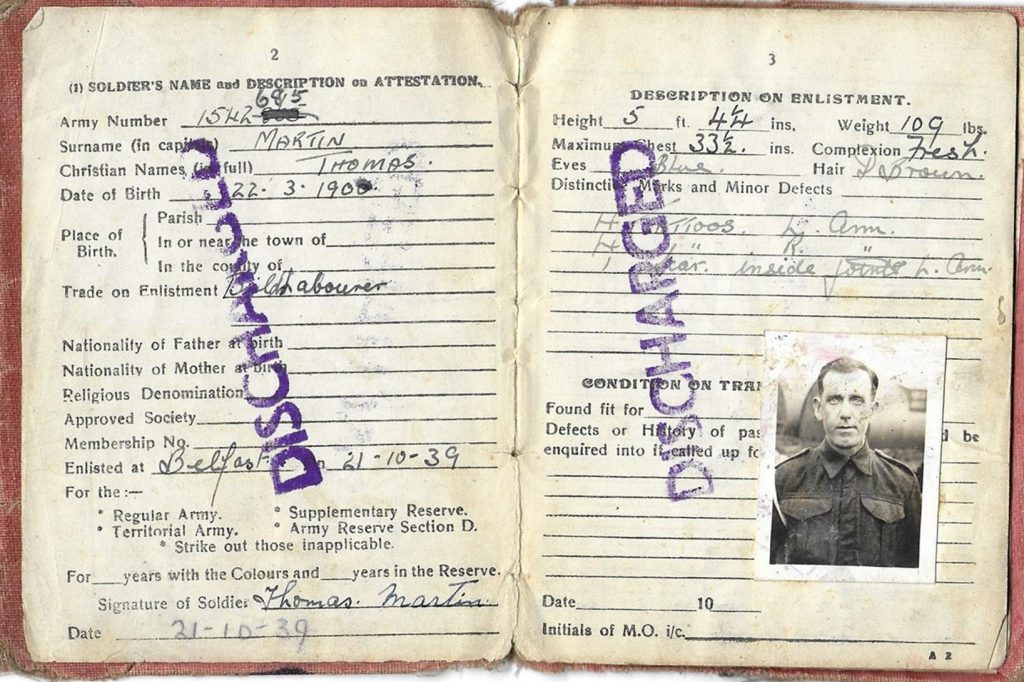 Part of Thomas Martin’s Army Book 64 Soldier’s Service and Pay Book
Part of Thomas Martin’s Army Book 64 Soldier’s Service and Pay Book
Attestation Books
There are two important attestation collections which can be searched on Findmypast. This is a fee-paying website that offers a free trial period and you’ll be taken to the site if you click on the banner below. They are Royal Artillery Attestations 1883-1942 and Royal Tank Corps Enlistment Records 1919-1934. A recruit’s information was entered when they joined the corps. However, they are only useful if the soldier in question joined the Royal Artillery prior to April 1942 (when the General Service Corps was formed) or one of the regiments which made up the Royal Tank Corps between 1919 and 1934. You’ll find men who enlisted in the Hussar, Lancer, Dragoon and Dragoon Guards regiments prior to their mechanization in this collection. There’s a lot of information in the books, with a person’s place of birth, age and next of kin recorded, along with their campaigns and date of discharge or reason for becoming non-effective.
Around 1929, the Royal Artillery’s attestation book changes the information which was recorded and only a soldier’s full name and army number are guaranteed to appear. There is often a note regarding what happened to a soldier, for example, if they were sent to the reserve or were transferred to another corps or to a regiment. With this information, you can often work out the correct soldier or at least narrow it down to a couple of possibilities, unless you’re looking for a John Smith!
There are also regimental number books for the Grenadier Guards as part of the WO 437 series at the National Archives. Most of these books have the same layout as the Royal Artillery Attestation Books, recording a new recruit’s army number, name, and if they transferred to another corps or became non-effective.
Regimental Journals
If you’re researching a soldier who served in the inter-war period, then a regimental journal may hold the key to finding their army number. Not all regiments/corps published a journal but most did and these often contain sections recording births, marriages and deaths where you can find army numbers. The extract below was taken from The Crossbelts, The Journal of the VIII King’s Royal Irish Hussars: Volume 3: No.1: 1935. There may also be a section in journals recording promotions, postings, enlistments and discharges. Again, an army number is often recorded. To find out if a regiment/corps published a journal, look up its entry in the May 1939 Army List available to view for free on the National Library of Scotland’s website. If a journal was published, then it will be listed below a regiment’s/corps’ title.
Unfortunately, journals are quite difficult to find, as only a small number have been digitized and can be viewed online. Regimental/corps’ museums often have a set, the Imperial War Museum has a reasonable collection but your best bet is to visit the British Library in London. You can search for the journals using the main catalogue, however, you will need a reader’s pass to view them. Nearly all of the journals have to be ordered 48 hours in advance which can make viewing difficult.
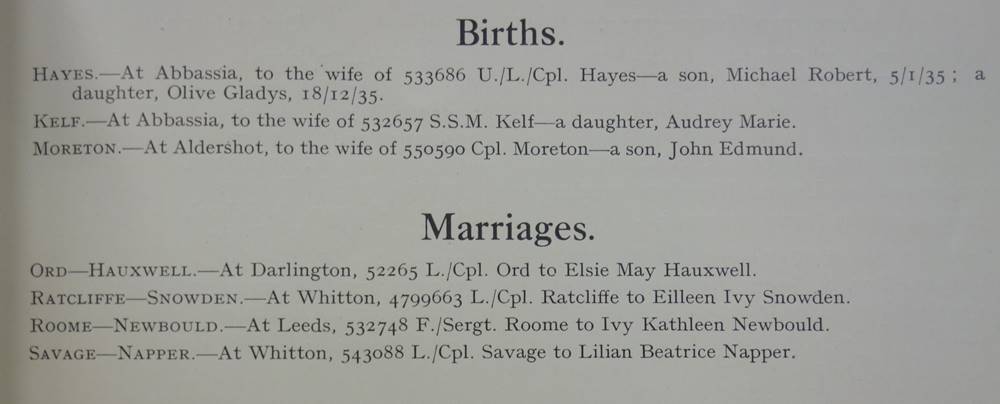 An extract from The Journal of the VIII King’s Royal Irish Hussars recording army numbers
An extract from The Journal of the VIII King’s Royal Irish Hussars recording army numbers
War Diaries
War diaries offer a good chance of finding a soldier’s army number. Unfortunately, you will need to know a bit about the soldier’s service to know which war diaries to check. If you’re trying to find a soldier who served in the Royal Artillery or Royal Army Service Corps and that’s all you know, then there’s very little chance of success. However, if the soldier you’re researching served in an infantry regiment and you know they served in Ceylon (Sri Lanka), Egypt or Sicily etc., then you can often identify the war diaries you need to check relatively quickly.
For example, if the soldier you’re researching served in the Northamptonshire Regiment and you know they served on Madagascar. Only the 2nd Battalion Northamptonshire Regiment served on the island so you’d want to look at the Battalion’s war diaries. Compared to the First World War, there was not a lot of infantry in the Second World War, so even if you only know the regiment and they were at Normandy, it’s not an impossible task. However, soldiers were often transferred between regiments so you have to be careful.
There are a variety of documents in the war diary which will record army numbers. If a soldier was in an accident or injured themselves badly, especially while training with weapons, they often appear in the daily entry. However, it is a war diary’s appendices which offer the best chance. Regimental orders are great documents in this respect, though only found in a small number of war diaries and usually only for units serving in Britain. The regimental orders below is from the war diary of the 3rd County of London Yeomanry (Sharpshooters) which has a complete set for the first year of the war. Nearly every man of the regiment appears at least once, as they record appointments, training courses and men going on leave.
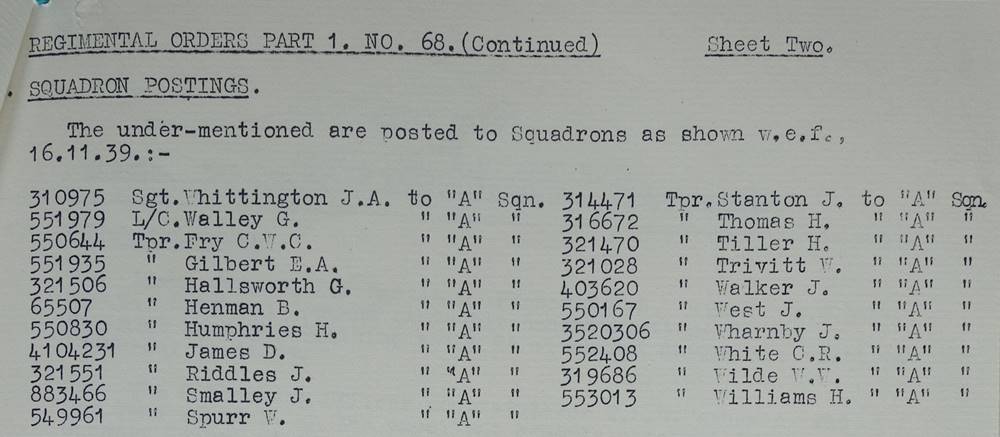 An extract from a regimental orders of the 3rd County of London Yeomanry (Sharpshooters)
An extract from a regimental orders of the 3rd County of London Yeomanry (Sharpshooters)
Another important source for army numbers is nominal rolls. Unfortunately, these are few and far between. You’ll often find them when a unit is about to embark for overseas service with the nominal roll below appearing in the war diary of the 2nd Battalion Welsh Guards and recording those heading for Boulogne to take part in the defence of the port. Nominal rolls are often divided up by company/squadron which can make them invaluable for tracking a soldier’s movements, as units were frequently split up.
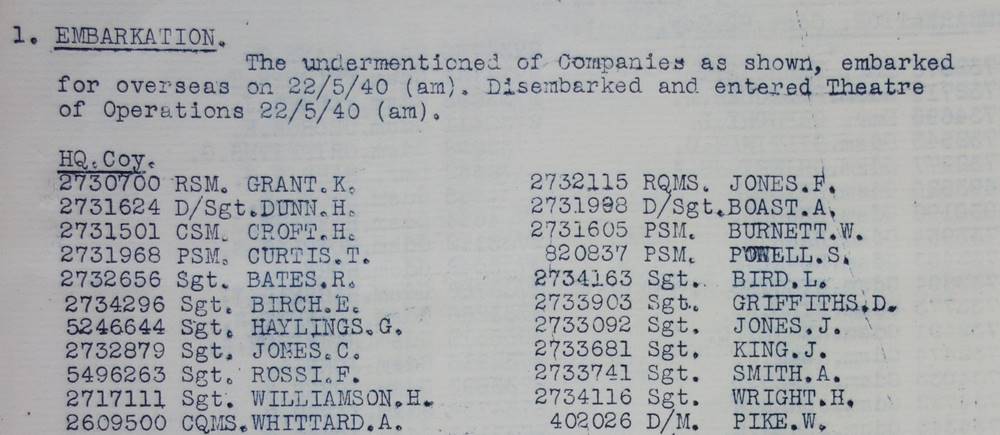 Part of a nominal roll for the 2nd Battalion Welsh Guards
Part of a nominal roll for the 2nd Battalion Welsh Guards
You’ll also find army numbers appearing on a variety of other documents in the appendices. One of the most important is Army Form A.3009 Field Return of Other Ranks. This form usually appears once a unit was abroad and it is “Part C Description of other ranks whose return to the unit is particularly requested” which will contain army numbers if it has been filled in correctly. Unfortunately, a lot of them have been left blank. In ideal circumstances, Part C should record a soldier’s army number, rank, name, regiment and a remarks column “e.g. present whereabouts if known”. This section is useful if you’re researching a soldier who became ill and was sent away for medical treatment, as they don’t appear in casualty lists.
If a Soldier Died During the War
If the soldier you’d like to research died between 3 September 1939 and 31 December 1947, then you can search for them on the Commonwealth War Graves Commission’s (CWGC) website. When searching for a soldier by their name bear in mind that some first names are recorded as initials only. You can customise your search by regiment, unit, cemetery, date of death, country they are commemorated in etc.
What makes the CWGC’s website such a key record set for finding a soldier’s army number is that it contains both military and biographical information which can be used to identify the correct soldier. Take for example Private Reginald Panton, who was killed in action on 12 February 1942 and buried in Pembroke Military Cemetery in Malta. On Reginald’s register entry for the CWGC, it was recorded that he was the “son of Henry Charles and Alice Panton, of Chatham”. An army number was always recorded, described as a service number on the website which will enable you to order their service record. If a soldier died in service, you don’t need a death certificate or permission of the next of kin to order their file.
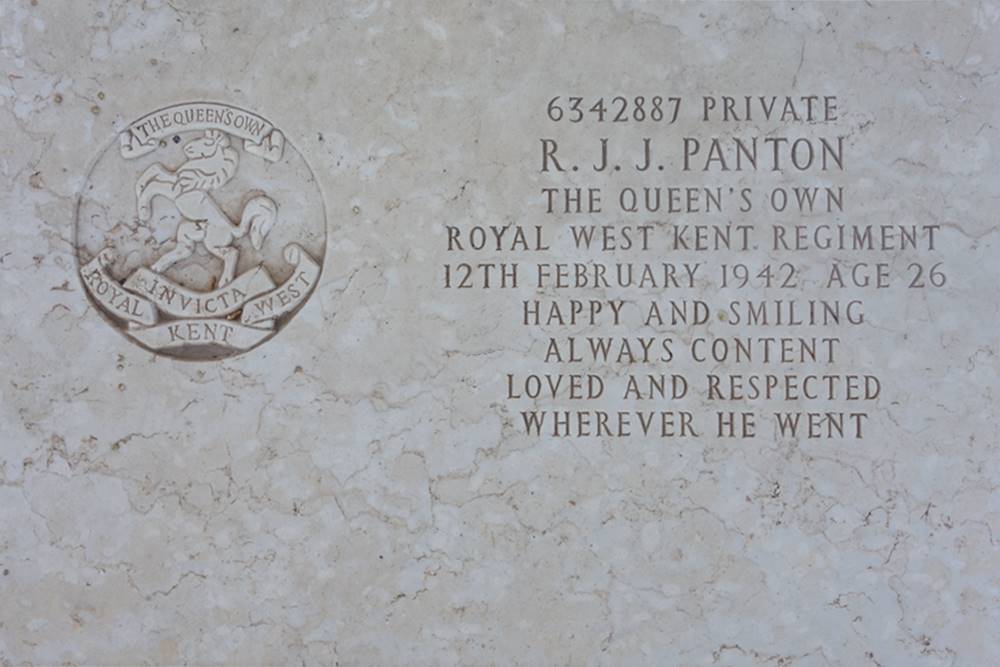 The headstone of Private Reginald Panton
The headstone of Private Reginald Panton
British Army Casualty Lists and Prisoner of War Records
During the Second World War, the British Army published casualty lists recording officers and other ranks who had lost their lives, were wounded, went missing or were confirmed as prisoners of war. If you’re researching a soldier who died during the war and trying to find their army number, use the Commonwealth War Graves Commission website instead. The casualty lists are most useful for those who were wounded or went missing. Even for common surnames like Smith and Jones, you can often find the correct soldier providing you know some information about their service. For example, if you know they were wounded in Sicily serving with the Devonshire Regiment or they were taken prisoner at Dunkirk in 1940 while serving with the Royal Artillery, there won’t be many possibilities, even for common surnames. The casualty lists can be searched on FindmyPast which offers a free trial.
If a soldier was taken prisoner of war in Europe and you have multiple possibilities, search their army number in the National Archives’ catalogue. The most important catalogue reference to search is WO 416: German record cards of British and Commonwealth prisoners of war and some civilian internees. This collection of cards usually records the soldier’s place and date of birth in their catalogue entry. Further biographical information can be found on the cards, including their next of kin. Another possible source of information is the WO 344 series of Liberated Prisoner of War Interrogation Questionnaires. Not every soldier completed this questionnaire but if they did, it will record their date of birth, address, and trade. A signature will also appear. Part of this series has been digitized and can be viewed on Ancestry.
Gallantry Medals and Mentioned in Despatches
If the soldier you’re researching was awarded a gallantry medal, for example, the military medal or distinguished conduct medal, you can search their name in the WO 373 series using the National Archives’ catalogue. However, you will need to know some information already if you’re searching for a common name. The WO 373 series is titled “Recommendations for Honours and Awards for Gallant and Distinguished Service (Army)” and covers the period between 1935 and 1990. The citation cards are free to download but you need to register first. If you click on a result you will be shown the name, rank, army number, unit, theatre of operation and the award they were recommended for. From this information, hopefully, you’ll be able to work out if you have found the correct person.
To find a mentioned in despatches, you’ll need to search a soldier’s name on the London Gazette. The difficulty with relying on a mentioned in despatches is you’re more likely to be faced with multiple individuals with the same name. In addition, the London Gazette’s search engine is poor and confuses letters, so it will often miss names. If you find a soldier in a list of those awarded a mention, make sure you go back in that gazette edition to find the start of the list. There will be a paragraph recording which despatch the men were mentioned in.
Military Discharge Indexes, 1920-1971
This important database contains the army numbers of soldiers who served in the British Army past 1920 and were born prior to 1901 whose service records are still held by the Ministry of Defence. The database can be searched on Ancestry. However, it has a number of downsides. Not every soldier appears who should, the dates of birth are sometimes wrong and only initials are used. Despite these problems, it is still a very useful database. Officers will also be shown with their personal number.
Birth, Marriage and Death Certificates
When a soldier got married during the war, had a child or their wife died, information relating to their military service was often recorded on the certificate. You can never tell until you order a certificate how much information it will contain. In the worst-case scenario, it will simply record “soldier”. Even if no army number was recorded, they often contain key information which may hold the clue to working out a soldier’s service. For example, they will usually provide at least the regiment or corps and often the rank, e.g. “Corporal Grenadier Guards”. I have seen plenty of army numbers on certificates so it’s by no means rare. When my great-grandmother died while my great-grandfather was serving abroad, his army number was recorded on her death certificate. Use the following links depending on where the event took place:
- England and Wales: General Register Office
- Scotland: National Records of Scotland
- Northern Ireland: General Register Office for Northern Ireland
- Ireland: Health Service Executive
Medal Rolls
There are a large number of medal rolls which have been digitized by the National Archives and can be downloaded on their website for free. The medal records are part of the WO 100 series which contains the names of well over a hundred thousand soldiers with their army numbers for the inter-war and post-war period. The most useful medal rolls are those for the General Service Medal with clasps Palestine 1945-48 and S. E. Asia 1945-46 due to the large numbers of Second World War soldiers qualifying for them. The medal rolls are divided by regiment/corps. These have been indexed on Ancestry and can be searched in Campaign Medal and Award Rolls, 1793-1949 (General Series).
Field General Court-Martial Records
The WO 213 series at the National Archives contains books listing Field General Court-Martials held in both Britain and abroad. These books list the army number of those who were tried for a variety of crimes/offences e.g. theft, losing property, self-inflicted wounds, mutiny, desertion. The downside is that you’re going to have to know that the soldier in question got into trouble during their service, had a Field General Court-Martial and then spend a lot of time looking through the books. Also, you will need an uncommon surname as only initials were recorded.
First World War Medal Records
There weren’t many soldiers who served continuously between the wars, so First World War medal records aren’t particularly useful for working out the army number of Second World War soldiers. However, they can be very helpful if a soldier continued to serve in the 1920s. Many soldiers took a generous bounty in 1919 rather than be demobilized and remained in the army.
There are two sets of documents to look for. The first is a Medal Index Card which is available to view for free on Ancestry. It can be difficult to tell which is an army number and which is a regimental number. First, look at my page on army numbers and see if the number on the Medal Index Card matches the number block of the regiment or corps. This is actually quite difficult to do if you don’t have knowledge of regimental numbers, as you can easily go astray, with some numbering blocks falling within the old regimental number system. Often, an army number won’t be recorded on the card.
The second document which is far more likely to contain an army number is the Medal Roll for the British War Medal and Victory Medal which is also available on Ancestry. When an army number appears, “still serving” was often written in the remarks column. I’ve never seen an army number appear on a 1914 or 1914/15 Star Medal Roll, though that’s not to say none exist on these documents.
